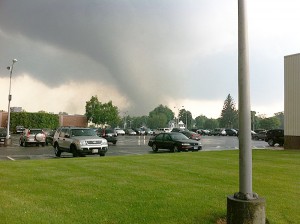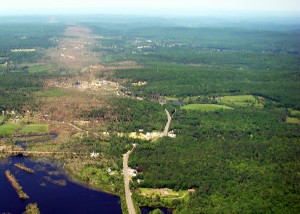By George Harvey, staff
The IPCC has released the third part of its Fifth Assessment Report. The first two parts were a summary for policy makers, released in September of 2013, and a report on impacts and vulnerabilities of climate change, released in March of 2014. The third part is about mitigation – what we can do to make things better. A fourth part, a synthesis of all this, will be released in October.
These reports are the result of the work of several thousand experts in climatology, meteorology, and related studies. They are based on the available peer-reviewed literature; just the first part of the report referenced 9,200 of these.

Your new neighbor, brought to you courtesy of climate change: Tornado of June 1, 2011, bearing down on Springfield, Massachusetts. Photo by Mark Putzel
We should bear in mind that there is broad agreement on the reality and causes of climate change among the scientists in the relevant fields, with virtually no denial that the problem exists and is important. Any impression to the contrary is almost certainly the result of inaccurate reporting, the causes of which are subject to speculation.
The first important point of the report is that we are all threatened by climate change, and we must all act to get out of it. Those who fail to act by persisting in the old unsustainable practices are increasing risks and impeding progress. This is not something to let someone else take care of – we must all participate.
The good news is that we can limit the damage. Indeed, we can continue to live comfortably while we address climate change. Furthermore, as it happens, doing this will alleviate poverty in much of the world. This does not require an underlying change in our politics or religious beliefs – it only requires wise action.
One thing we need to do is to understand and implement the principles of sustainable growth. This is the antithesis of making as much money as possible, or getting as much power as possible, without regard to the remote future. This does not mean an end of profit. In fact many companies find that by becoming sustainable, their profits increase. It does mean addressing the issue. It means that cost-benefit analysis can be used, but it may imply that ethical values also be considered fully.

Aerial view of tornado damage in western Massachusetts following the June 1, 2011 tornados. Photo by Massachusetts Department of Environmental Protection
Part of the problem we face is that greenhouse gas (GHG) emissions are growing, even as we address the problems. We are increasing efficiency and renewable power generation, but nowhere near as quickly as we need to do. The report summary says, “About half of cumulative anthropogenic CO2 emissions between 1750 and 2010 have occurred in the last 40 years.”
The report indicates that if we can keep the CO2 concentrations below 500 ppm in 2100, then we will probably be able to keep overall global warming to less than 2° C. We are already at 400 ppm, and the number is growing. What we have to do is limit the emissions of all GHGs to nearly 0. This may sound difficult, but the projection is that we can actually do better than that, getting to the point where we remove GHGs from the atmosphere faster than we put them in, if enough of us act quickly and wisely.
The key components of GHG reduction strategy are things we already know and already do. Reduction of fossil fuel use for generating power is vital. It is also imminently achievable using technologies we already have and use. Increasing the use of solar PVs, wind power, hydropower, and biomass are all well known, and can be done wisely. If wisely done, they will limit environmental damage without decreasing comfort. There may be other technologies that can be added to this mix, with the most promising possibly being geothermal power generation. But the key is to make wise choices quickly.
Heating buildings is another important issue for climate change. Here again, the issue can be addressed using known technologies. Increasing effectiveness of insulation and air sealing, and switching to more efficient GHG-free heating systems are key strategies. If we use biomass for heating, it has to be free of particulate emissions. Green Energy Times has run articles on Passive Houses and net-zero buildings, which require nearly no power for heat, and this approach has already been achieved, both for new buildings and for retrofits.
Transportation is another important sector in which improvements can be made. We already have electric vehicles. We also have cars that can be powered with biofuels. We can decrease our emissions while improving health and the condition of our pocketbooks by walking or biking more and using automobiles less. We can also switch to public transportation.
The IPCC report acknowledges that we could reduce some of our carbon emissions by increasing our use of nuclear power and switching from burning coal to burning natural gas. It also clearly states that there are difficulties with both technologies. In particular, natural gas, used in ever greater quantities, is still a fossil fuel, and if what are called “fugitive emissions” of its methane are not eliminated, natural gas can be even worse than coal in producing GHGs. Fugitive emissions are a problem in many places where fracking is done.
The briefest possible summary of the report is that we already know what to do now, and we already have the tools to do it. What we need is to act.








Leave a Reply